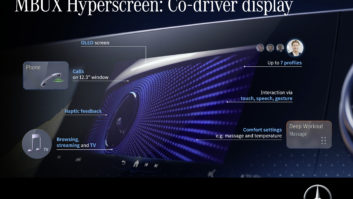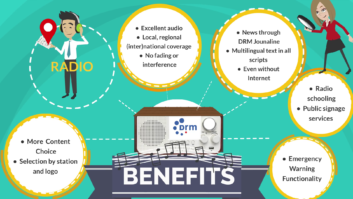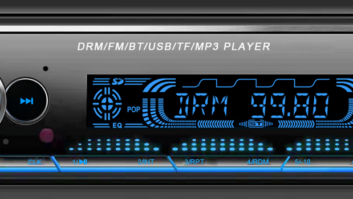The author is project director for WorldDAB.
In the last 12 months DAB has reached a number of significant milestones. Across the world, more than 475 million people are now covered by DAB services and over 70 million receivers have been sold.

In Europe DAB+ is firmly established as the core future platform for radio, with Norway having completed its digital switchover process last year, Switzerland starting from 2020 and the United Kingdom reaching over 50 percent digital listening — where the government will undertake a review to assess digital radio progress and determine next steps in due course.
TRANSITION
Following DSO in Norway we’re seeing listening figures stabilize and it’s clear that listeners love their new stations. The old stations were more tolerated than loved and now one-third of all listening happens on the new stations. In Germany, a significant consumer marketing campaign has been taking place, driving digital listening and awareness. In Italy, public broadcaster Rai has approved the extension of DAB+ coverage, which will include most of Italy’s motorways, and Belgium expects to cover 99 percent of the population by the end of 2018.

The EU has approved the new European Electronic Communications Code, requiring all new car radios in the EU to be capable of receiving digital terrestrial radio. Italy and France already have similar receiver legislation in place. The Italian law comes into effect in 2020.
In France, the recent launches of DAB+ in Strasbourg and Lyon will help reach 20 percent population coverage, the threshold needed to trigger a law requiring French manufacturers to include a DAB+ chip in their equipment within 18 months.
Significantly, all major French private radio groups have responded to the call for tenders launched by the CSA earlier this year, with applications from smaller broadcasters expected to follow suit.
With these developments, France joined the European family of DAB nations — Germany, Italy, Switzerland, Belgium, the Netherlands, Norway, Denmark, Slovenia, Serbia and the United Kingdom.
Other markets are also following — Austria, Croatia, the Czech Republic, Greece, Poland, Slovakia and Ukraine are all taking early steps on the DAB journey. Austria will launch national DAB+ services in 2019, Croatia has issued a call for interest for a DAB+ trial, in Greece DAB+ frequencies have been allocated for a national deployment of DAB+ and the first licensing law for DAB+ stations was passed in January 2018 and in Ukraine, four more DAB+ services were added in July 2018.
This year WorldDAB announced that, for the first time, there is a worldwide common logo and complete toolkit for DAB+ branding and marketing. Leading manufacturers are now using this new international DAB+ logo, Major consumer electronics manufacturers across Europe have now started displaying the new logo on their packaging, in an aligned effort to benefit from the growing adoption of DAB+ in Europe and beyond. The logo is free to use for all industry stakeholders and is available to download from the WorldDAB website.
DEVELOPING MARKETS
Slovenia issued licenses for 13 stations for its first DAB+ network and the Broadcasting Council has proposed a switchover for the main channel of Slovenian radio stations to digital broadcasting to commence on Feb. 22, 2022.
Outside Europe we’ve seen encouraging developments in South Africa, where the Deputy Minister of Communications Pinky Kekana stressed the benefits and importance of implementing digital radio, calling DAB+ “a game changer.”
With many other countries watching closely, the development of digital radio in South Africa will have an impact across the continent. In Asia-Pacific, Australia continues to lead the way with DAB+ gaining 168,000 listeners to reach 3.6 million in the five metropolitan capital cities, according to the latest digital radio report by GfK.
[Read: WorldCast Audemat DAB Probe Monitors Signal Quality]
The total number of DAB+ receivers in Australia has now reached 4.4 million, including over 800,000 in-car units, as well as portable digital radios and home receivers sold through retailers. Thailand is soon to launch DAB+ trials and we’re seeing strong interest from the rest of the region. WorldDAB has held a number of workshops in partnership with the Asia Pacific Broadcasting Union on how to implement DAB+ services — the last saw delegates from 17 countries in Africa, the Middle East, South East Asia and the Pacific and we will be running more of these in 2019.
Kuwait launched new DAB+ services in February 2018, with 16 services now on-air across the country and in the United Arab Emirates, The Telecommunication Regulatory Authority is working to introduce DAB+. All of these developments are being driven by the need for radio to remain relevant in the face of new competition. Where FM spectrum is full, DAB+ addresses this situation by offering listeners new features and many more services.
In developed markets we are seeing the proof that audiences love these new services — In the U.K, 19 million people each week listen to services not available to them on analogue networks.
This has helped drive U.K. radio to new levels of success — and, in the last four years, advertising revenues have grown by 27 percent. All this has been achieved with a platform, which is free-to-air and with no reliance on third-party gatekeepers. As radio continues to go from strength to strength around the world, we look forward to welcoming even more listeners and broadcasters to the DAB+ family.







